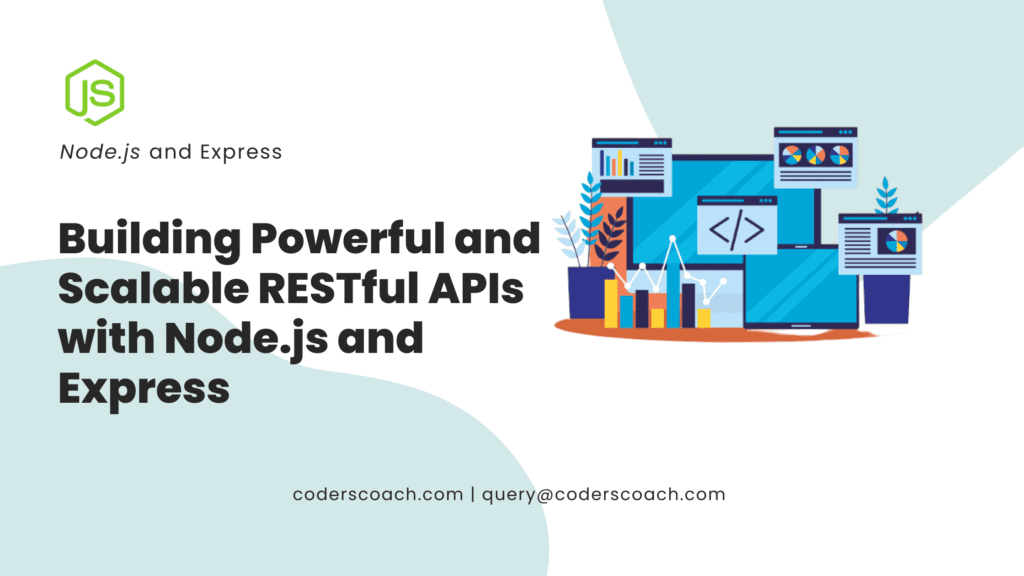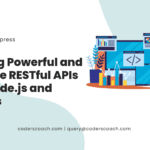Introduction to RESTful APIs
In the modern web development landscape, RESTful APIs have become the backbone of many applications, enabling communication and data exchange between different systems. A well-designed API should be scalable, efficient, and easy to use. In this article, we will explore how to create a scalable RESTful API using Node.js and Express.
Understanding Node.js and Express
Node.js is a powerful JavaScript runtime built on Chrome’s V8 JavaScript engine. It allows developers to write server-side applications using JavaScript, which brings numerous benefits such as code reuse and a unified language across the entire application stack. Express, on the other hand, is a minimal and flexible web application framework for Node.js that provides a robust set of features for building web APIs.
Setting up the Development Environment
Before diving into API development, we need to set up our development environment. Firstly, make sure you have Node.js installed on your machine. You can check the version by running node -v in your command line interface. If Node.js is not installed, download and install the latest version from the official Node.js website. Once installed, you can verify the installation by running node -v again.
Next, we need to initialize a new Node.js project. Open your terminal or command prompt, navigate to the desired project directory, and run npm init to create a new package.json file. This file will track our project dependencies and configuration.
Designing the API Architecture
A well-designed API architecture is crucial for scalability and maintainability. We need to define the routes, handlers, and models for our API. Begin by deciding the resources your API will expose and the corresponding endpoints. RESTful APIs follow a resource-based approach, where each resource is identified by a unique URL and can be manipulated using HTTP methods.
For example, let’s consider an API for managing user data. We can define the following endpoints:
GET /users– Retrieve a list of usersPOST /users– Create a new userGET /users/:id– Retrieve a specific userPUT /users/:id– Update a specific userDELETE /users/:id– Delete a specific user
Handling HTTP Methods and Routes
With the API architecture in place, we can start implementing the routing and handling of HTTP methods. Express provides a clean and intuitive way to define routes using the express.Router class. We can create a separate router file for each resource and mount them on the main Express app.
Here’s an example of how we can define the routes for user management:
const express = require('express');
const router = express.Router();
// GET /users
router.get('/', (req, res) => {
// Logic to retrieve and return a list of users
});
// POST /users
router.post('/', (req, res) => {
// Logic to create a new user
});
// GET /users/:id
router.get('/:id', (req, res) => {
// Logic to retrieve and return a specific user
});
// PUT /users
/:id
router.put('/:id', (req, res) => {
// Logic to update a specific user
});
// DELETE /users/:id
router.delete('/:id', (req, res) => {
// Logic to delete a specific user
});
module.exports = router;Implementing CRUD Operations
Now that we have defined our routes, we can focus on implementing the CRUD (Create, Read, Update, Delete) operations for each resource. These operations involve interacting with a database or any other data storage mechanism.
For instance, when handling the POST /users route, we would need to extract the user data from the request body, validate it, and then save it to the database.
router.post('/', (req, res) => {
const userData = req.body;
// Validate user data
if (!isValidUser(userData)) {
return res.status(400).json({ error: 'Invalid user data' });
}
// Save user to the database
User.create(userData)
.then((user) => {
res.status(201).json(user);
})
.catch((error) => {
res.status(500).json({ error: 'Internal server error' });
});
});Data Validation and Error Handling
Data validation is a crucial step to ensure the integrity and security of our API. Express provides middleware such as express-validator that makes data validation a breeze. We can define validation rules for each route and handle any validation errors gracefully.
Error handling is equally important to provide meaningful feedback to API consumers. We can use middleware to catch errors and return appropriate error responses with the corresponding HTTP status codes.
Authentication and Authorization
Securing our API is essential to prevent unauthorized access and protect sensitive data. We can implement authentication and authorization mechanisms to ensure that only authenticated users can access certain resources or perform specific actions.
There are various strategies for authentication, such as token-based authentication using JSON Web Tokens (JWT) or session-based authentication using cookies. Similarly, authorization can be achieved by assigning different roles or permissions to users and checking those roles before allowing access to certain routes.
Testing the API
To ensure the correctness and robustness of our API, we need to write automated tests. Testing helps us catch bugs and regressions early in the development process, making our API more reliable.
There are several testing frameworks available for Node.js, such as Mocha and Jest. These frameworks allow us to write unit tests, integration tests, and end-to-end tests to cover different aspects of our API.
API Documentation
Good API documentation is essential for developers who want to integrate with our API. It provides clear instructions on how to use the API, lists available endpoints, and explains the expected request and response formats.
Tools like Swagger or Postman can help generate interactive API documentation automatically based on our code and annotations.
Performance Optimization
Scalability and performance are critical factors for any API. As the number of users and requests grows, we need to ensure that our API can handle the load efficiently.
Some performance optimization techniques include caching frequently accessed data, optimizing database queries, using indexing for faster data retrieval, and employing load balancing and clustering techniques.
Deployment and Scalability
Once we have developed and tested our API locally, it’s time to deploy it to a production environment. There are various hosting options available, such as cloud platforms like AWS or Heroku, or traditional servers.
Additionally, as the user base and traffic increase, we need to ensure our API can scale horizontally by adding more servers or using containerization technologies like Docker and Kubernetes.
Best Practices for RESTful API Development
When developing RESTful APIs, it’s essential to follow best practices to ensure consistency, maintainability, and ease of
use. Some key best practices include:
- Using descriptive and meaningful resource names
- Choosing appropriate HTTP status codes for responses
- Handling errors consistently
- Versioning APIs to allow for backward compatibility
- Applying rate limiting and throttling mechanisms to prevent abuse
- Implementing pagination and filtering for large data sets
- Keeping the API documentation up to date
Conclusion
Creating a scalable RESTful API with Node.js and Express is a powerful way to build robust web applications. By following best practices, designing a well-structured architecture, and incorporating proper validation, authentication, and documentation, we can create APIs that are efficient, secure, and easy to integrate with.
Frequently Asked Questions (FAQs)
What is a RESTful API?
A RESTful API is an architectural style for designing networked applications. It uses HTTP methods and URLs to manipulate resources.
Why should I choose Node.js and Express for API development?
Node.js allows you to write server-side applications using JavaScript, providing code reuse and a unified language across the entire application stack. Express is a minimal and flexible web framework that simplifies API development.
How can I secure my RESTful API?
You can secure your API by implementing authentication and authorization mechanisms, such as token-based authentication using JSON Web Tokens (JWT) or session-based authentication using cookies.
How can I test my API?
You can write automated tests using testing frameworks like Mocha or Jest. These frameworks allow you to write unit tests, integration tests, and end-to-end tests to ensure the correctness of your API.
What are some best practices for RESTful API development?
Some best practices include using descriptive resource names, choosing appropriate HTTP status codes, handling errors consistently, versioning APIs, applying rate limiting and throttling, and keeping the API documentation up to date.







